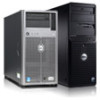Dell PowerEdge M520 Technical Guide - Page 20
Table 9., Memory RAS features
 |
View all Dell PowerEdge M520 manuals
Add to My Manuals
Save this manual to your list of manuals |
Page 20 highlights
Feature Table 9. Memory RAS features Description Dense configuration optimized profile Memory demand and patrol scrubbing Recovery from single DRAM device failure (SDDC) Failed DIMM isolation Memory mirroring: intra-socket Memory address parity protection Memory sparing (rank) Memory thermal throttling Increased memory reliability can be a result from this selectable platform profile that adjusts parameters to reduce faults regarding refresh rates, speed, temperature and voltage. Demand scrubbing is the ability to write corrected data back to the memory once a correctable error is detected on a read transaction. Patrol scrubbing proactively searches the system memory, repairing correctable errors. Recovery from Single DRAM Device Failure (SDDC) provides error checking and correction that protects against any single memory chip failure as well as multi-bit errors from any portion of a single memory chip. This feature provides the ability to identify a specific failing DIMM channel pair, thereby enabling the user to replace only the failed DIMM pair. Memory mirroring is a method of keeping a duplicate (secondary or mirrored) copy of the contents of memory as a redundant backup for use if the primary memory fails. The mirrored copy of the memory is stored in memory of the same processor socket. This feature provides the ability to detect transient errors on the address lines of the DDR channel. Memory sparing allocates one rank per channel as a spare. If excessive correctable errors occur in a rank or channel, they are moved to the spare area while the operating system is running to prevent the errors from causing an uncorrectable failure. This feature helps to optimize power/performance and can also be used to prevent DIMMs from overheating. For information on memory mirroring and sparing configurations, see the Dell PowerEdge M520 Systems Owner's Manual on Dell.com/Support/Manuals. Memory RAID is not supported. 20 PowerEdge M520 Technical Guide















